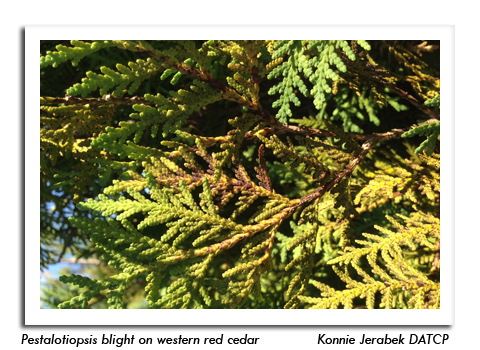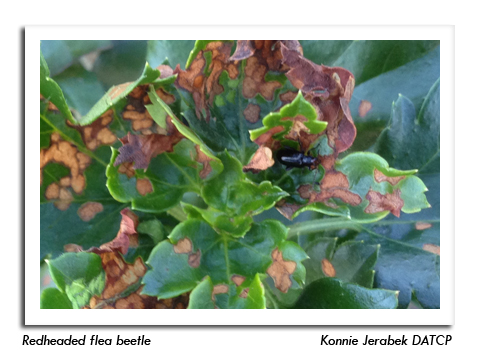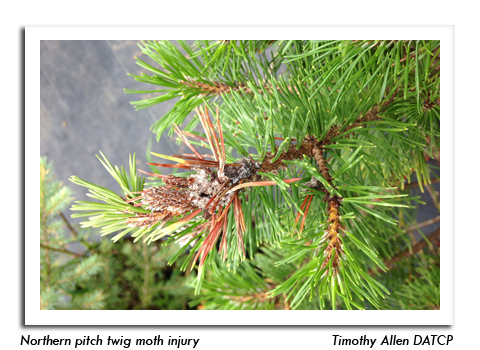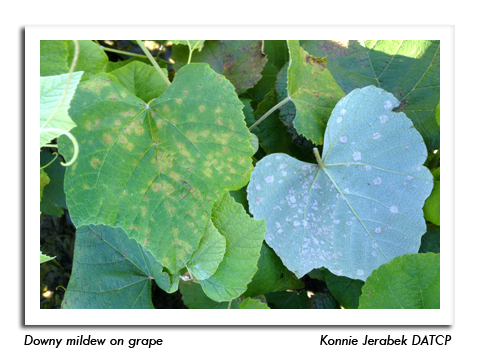
 |
|
|
Nursery & Forest
Volume 61 Number 18 Date 09/01/2016 EUONYMUS SCALE - Nursery inspectors noted a heavy scale infestation on 'Wintercreeper' euonymus in Kenosha County. This armored scale insect inhibits photosynthesis, reduces plant vigor and may kill entire plants. Severe problems are more likely to occur where plants are crowded or close to building foundations. Control measures include pruning out and destroying infested branches before the mobile crawlers emerge in early summer, or applying insecticidal soaps or oils to newly hatched crawlers, with four applications 10-12 days apart. Nursery growers and retailers are advised to carefully examine euonymus stock for this pest and reject or cull any infested plants. PESTALOTIOPSIS BLIGHT - This fungal blight was diagnosed on western red cedar (Thuja plicata) from a Dodge County nursery field. Pestalotiopsis is a stress-related problem triggered by unfavorable environmental conditions that eventually causes evergreen needles to turn black. Dead foliage should be pruned out to limit its spread. REDHEADED FLEA BEETLE - These shiny black beetles with prominent reddish heads were abundant on the leaves and shoot tips of ornamental shrubs and perennials at a nursery grower location in Jackson County. According to the inspector's report, several alpine currant, hydrangea, ninebark and weigela plants were moderately damaged. Defoliation caused by flea beetle feeding varies by leaf type, appearing as skeletonizing or shredding on thinner leaves and a linear, leafminer-like pattern on the thicker, fleshy leaves of sedum and similar plants. Insecticides directed against the adults are the most effective control, but repeat applications are often required. -- Konnie Jerabek, DATCP Nursery Inspector ASPEN BLOTCH MINER - Damage to aspens is appearing across northeastern Wisconsin, in portions of Florence, Forest, Marinette, Oconto, Oneida and Vilas counties. Larvae of this insect feed between the leaf surfaces, forming stippled blotches on the upper leaf surface and large, blister-like circular lesions on the leaf underside. Severely infested trees appear green in the upper crown and brown below. Significant, long-term damage is not expected. FUSARIUM - This soilborne fungal pathogen, which can survive for years in soil and plant debris, was found on gladiolus plants in Sawyer County last month. Fusarium reduces plant growth and causes leaf yellowing that progressively worsens until the plant dies. Dead roots infected with fusarium appear dark, while infected corms may show varying degrees of discoloration and circular rotted areas. Cultural practices that minimize infection include planting in clean soil, using a four-year rotation, maintaining a slightly acidic soil pH, and promptly discarding diseased corms. Fungicide treatment can also reduce the incidence of Fusarium. NORTHERN PITCH TWIG MOTH - Minor damage caused by the northern pitch twig moth was observed in Oneida County on Mugo pine. The larva of this species begins feeding near the tip of new shoots in early summer, creating a small round feeding cavity covered by a protective resinous blister. The following spring it emerges and migrates to a lower feeding site on the same branch where it forms a new blister. Although first-year pitch twig moth feeding is usually inconsequential, second-year feeding is more destructive and can weaken or kill terminal leaders. DOWNY MILDEW - This common fungal disease was noted on the foliage of several grape varieties during recent nursery inspections in Jackson County. Downy mildew is characterized by the growth of whitish-gray mold on the lower leaf surface and corresponding yellowish-green or tan areas on the upper leaf surface. Its occurrence may be reduced by controlling humidity levels and by spacing plants to increase air circulation. The fungus overwinters as spores on old leaves or as mycelium in bud tissue. -- Timothy Allen, DATCP Nursery Inspector 





|
|
|